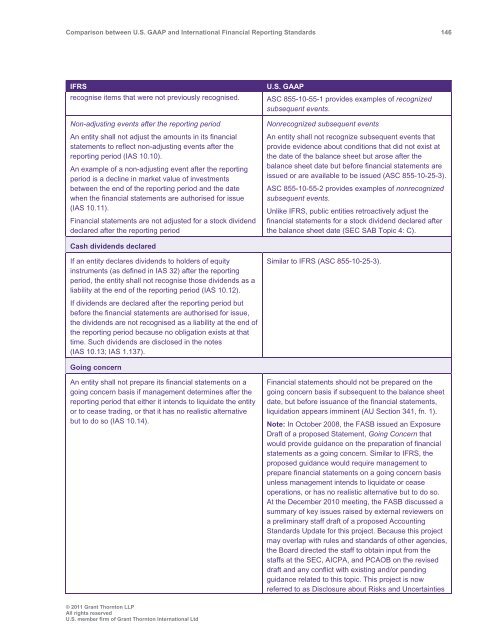Comparison between U.S. GAAP and International ... - Grant Thornton
Comparison between U.S. GAAP and International ... - Grant Thornton
Comparison between U.S. GAAP and International ... - Grant Thornton
Create successful ePaper yourself
Turn your PDF publications into a flip-book with our unique Google optimized e-Paper software.
<strong>Comparison</strong> <strong>between</strong> U.S. <strong>GAAP</strong> <strong>and</strong> <strong>International</strong> Financial Reporting St<strong>and</strong>ards 146<br />
IFRS<br />
recognise items that were not previously recognised.<br />
Non-adjusting events after the reporting period<br />
An entity shall not adjust the amounts in its financial<br />
statements to reflect non-adjusting events after the<br />
reporting period (IAS 10.10).<br />
An example of a non-adjusting event after the reporting<br />
period is a decline in market value of investments<br />
<strong>between</strong> the end of the reporting period <strong>and</strong> the date<br />
when the financial statements are authorised for issue<br />
(IAS 10.11).<br />
Financial statements are not adjusted for a stock dividend<br />
declared after the reporting period<br />
U.S. <strong>GAAP</strong><br />
ASC 855-10-55-1 provides examples of recognized<br />
subsequent events.<br />
Nonrecognized subsequent events<br />
An entity shall not recognize subsequent events that<br />
provide evidence about conditions that did not exist at<br />
the date of the balance sheet but arose after the<br />
balance sheet date but before financial statements are<br />
issued or are available to be issued (ASC 855-10-25-3).<br />
ASC 855-10-55-2 provides examples of nonrecognized<br />
subsequent events.<br />
Unlike IFRS, public entities retroactively adjust the<br />
financial statements for a stock dividend declared after<br />
the balance sheet date (SEC SAB Topic 4: C).<br />
Cash dividends declared<br />
If an entity declares dividends to holders of equity<br />
instruments (as defined in IAS 32) after the reporting<br />
period, the entity shall not recognise those dividends as a<br />
liability at the end of the reporting period (IAS 10.12).<br />
Similar to IFRS (ASC 855-10-25-3).<br />
If dividends are declared after the reporting period but<br />
before the financial statements are authorised for issue,<br />
the dividends are not recognised as a liability at the end of<br />
the reporting period because no obligation exists at that<br />
time. Such dividends are disclosed in the notes<br />
(IAS 10.13; IAS 1.137).<br />
Going concern<br />
An entity shall not prepare its financial statements on a<br />
going concern basis if management determines after the<br />
reporting period that either it intends to liquidate the entity<br />
or to cease trading, or that it has no realistic alternative<br />
but to do so (IAS 10.14).<br />
Financial statements should not be prepared on the<br />
going concern basis if subsequent to the balance sheet<br />
date, but before issuance of the financial statements,<br />
liquidation appears imminent (AU Section 341, fn. 1).<br />
Note: In October 2008, the FASB issued an Exposure<br />
Draft of a proposed Statement, Going Concern that<br />
would provide guidance on the preparation of financial<br />
statements as a going concern. Similar to IFRS, the<br />
proposed guidance would require management to<br />
prepare financial statements on a going concern basis<br />
unless management intends to liquidate or cease<br />
operations, or has no realistic alternative but to do so.<br />
At the December 2010 meeting, the FASB discussed a<br />
summary of key issues raised by external reviewers on<br />
a preliminary staff draft of a proposed Accounting<br />
St<strong>and</strong>ards Update for this project. Because this project<br />
may overlap with rules <strong>and</strong> st<strong>and</strong>ards of other agencies,<br />
the Board directed the staff to obtain input from the<br />
staffs at the SEC, AICPA, <strong>and</strong> PCAOB on the revised<br />
draft <strong>and</strong> any conflict with existing <strong>and</strong>/or pending<br />
guidance related to this topic. This project is now<br />
referred to as Disclosure about Risks <strong>and</strong> Uncertainties<br />
© 2011 <strong>Grant</strong> <strong>Thornton</strong> LLP<br />
All rights reserved<br />
U.S. member firm of <strong>Grant</strong> <strong>Thornton</strong> <strong>International</strong> Ltd
















